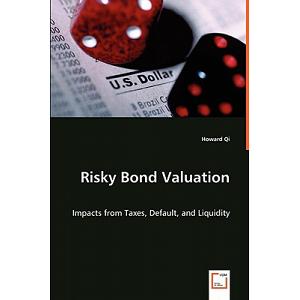Bond Valuation
1. Par (face) value – FV (Future Value), payable at maturity
2. Coupon Rate - %, annual coupon rate / face value
3. Coupon Payment - $, fixed periodic interest payment calculated as : coupon rate x Future Value
4. Maturity Date, determined at issue
Bond characteristic
Bond prices and market interest rates move in opposite directions:
1. When C = R, price = par value
2. When C > R, price > par value (premium bond)
3. When C < style="font-weight: bold;">Bond Valuation Formula
Bond Value = c ({1-[1/(1+R)T]} / R ) + (FV/ [1/(1+R)T])
Bond Types:
1. Pure Discount Bonds.
Also known as zeroes, it does not pay periodic coupon payments and sells at discount (less than par value).
Return or yield comes from the difference between the purchase price and the par value.
Valuation of pure discount bond:
PV = FV / /(1+R)T
2. Level Coupon Bonds.
Make periodic coupon payments plus par (face) value at maturity.
Therefore, the bond price (value) is the present value of annuity coupon payment and a terminal (maturity) value.
Coupon payments are normally semiannual.
For bond with semiannual coupon payment, apply = Tx2 and R/2 (ie m = 2).
Valuing bond example:
Find the value of bond if par value = $1000, T=20 years, c = 80% semiannual payment, if:
R = 10%., then T = 20x 2 = 40 and R = 10%/2 = 5%
P = c ({1-[1/(1+R)T]} / R ) + (FV/ [1/(1+R)T])
P = $40 ({1-[1/(1+0.05)40]} / 0.05 ) + ($1000/ [1/(1+0.05)40])
P = $828.41
When R is greater than coupon rate, the bond will sell at discount (less than par).
R = 6%, then R = 6% / 2 = 3% and T = 20 x 2 = 40
P = $40 ({1-[1/(1+0.03)40]} / 0.05 ) + ($1000/ [1/(1+0.03)40])
P = $ 1,231.15
When R is less than coupon rate, the bond will sell at a premium (greater than par).
3. Consols or perpetual bonds
Bonds that does not have maturity period and coupon paid every period till forever. Valuation thus like perpetuity:
PV = c / R
1. Par (face) value – FV (Future Value), payable at maturity
2. Coupon Rate - %, annual coupon rate / face value
3. Coupon Payment - $, fixed periodic interest payment calculated as : coupon rate x Future Value
4. Maturity Date, determined at issue
 |
| Risky Bond Valuation |
Bond prices and market interest rates move in opposite directions:
1. When C = R, price = par value
2. When C > R, price > par value (premium bond)
3. When C < style="font-weight: bold;">Bond Valuation Formula
Bond Value = c ({1-[1/(1+R)T]} / R ) + (FV/ [1/(1+R)T])
Bond Types:
1. Pure Discount Bonds.
Also known as zeroes, it does not pay periodic coupon payments and sells at discount (less than par value).
Return or yield comes from the difference between the purchase price and the par value.
Valuation of pure discount bond:
PV = FV / /(1+R)T
2. Level Coupon Bonds.
Make periodic coupon payments plus par (face) value at maturity.
Therefore, the bond price (value) is the present value of annuity coupon payment and a terminal (maturity) value.
Coupon payments are normally semiannual.
For bond with semiannual coupon payment, apply = Tx2 and R/2 (ie m = 2).
Valuing bond example:
Find the value of bond if par value = $1000, T=20 years, c = 80% semiannual payment, if:
R = 10%., then T = 20x 2 = 40 and R = 10%/2 = 5%
P = c ({1-[1/(1+R)T]} / R ) + (FV/ [1/(1+R)T])
P = $40 ({1-[1/(1+0.05)40]} / 0.05 ) + ($1000/ [1/(1+0.05)40])
P = $828.41
When R is greater than coupon rate, the bond will sell at discount (less than par).
R = 6%, then R = 6% / 2 = 3% and T = 20 x 2 = 40
P = $40 ({1-[1/(1+0.03)40]} / 0.05 ) + ($1000/ [1/(1+0.03)40])
P = $ 1,231.15
When R is less than coupon rate, the bond will sell at a premium (greater than par).
3. Consols or perpetual bonds
Bonds that does not have maturity period and coupon paid every period till forever. Valuation thus like perpetuity:
PV = c / R

No comments:
Post a Comment